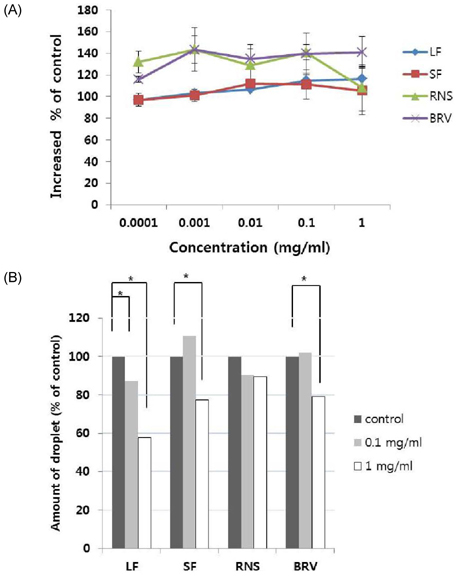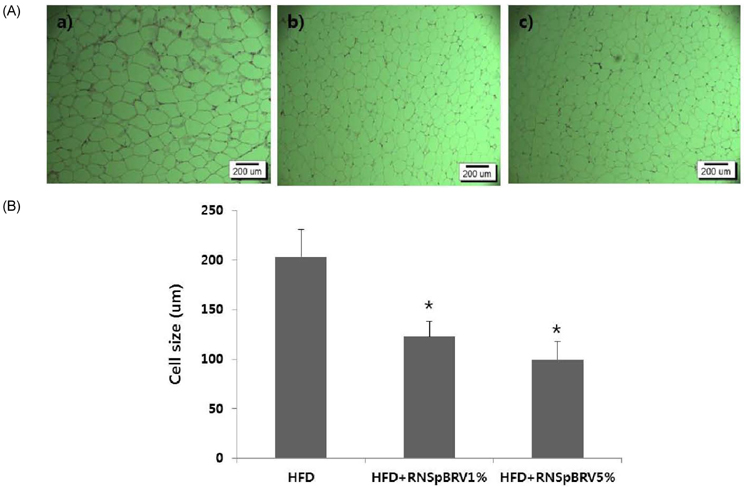Nutr Res Pract.
2013 Dec;7(6):453-459.
Anti-hyperlipidemic activity of Rhynchosia nulubilis seeds pickled with brown rice vinegar in mice fed a high-fat diet
- Affiliations
-
- 1Department of Food Science and Biotechnology, Sungkyunkwan University, Suwon 440-746, Korea.
- 2Major of Nano-Bioengineering, Incheon National University, 119 Academy-ro, Yeonsu-gu, Incheon 406-772, Korea. seungho@Incheon.ac.kr
Abstract
- The abnormal content of blood lipids often results in metabolic diseases, such as hyperlipidemia and obesity. Many agents, including natural sources from traditional food, have been developed to regulate the blood lipid contents. In this study, we examined the anti-hyperlipidemic activity of Rhynchosia nulubilis seeds pickled with brown rice vinegar (RNSpBRV), a Korean traditional pickled soybean food. Since RNSpBRV is made of R. nulubilis seeds (RNS) soaked in brown rice vinegar (BRV), we compared the anti-adipogenic activity between RNS, BRV and solid fraction of RNSpBRV (SF-RNSpBRV), liquid fraction of RNSpBRV (LF-RNSpBRV). For this, the inhibitory effect of lipid accumulation in 3T3-L1 adipocyte was checked by adding methanol extracts of mixed RNS and BRV, LF-RNSpBRV, and SF-RNSpBRV. The addition of each methanol extract up to 1 mg/ml showed no cytotoxicity on 3T3-L1 adipocyte, and approximately 20% of the lipid droplet formation was suppressed with the methanol extract of BRL or SF-RNSpBRV. The highest suppression (42.1%) was achieved with LF-RNSpBRV. In addition, mice fed a high fat diet (HFD) supplemented with 5% RNSpBRV powder led to increased high density lipoprotein (HDL) cholesterol and lower blood glucose, triglyceride, and total cholesterol compared to mice fed with a HFD diet only. Interestingly, the size of the epididymis cells gradually decreased in HFD + 1% RNSpBRV- and HFD + 5% RNSpBRV-fed mice if compared those of HFD-fed mice. Taken together, these results provide evidence that RNSpBRV has a regulatory role in lipid metabolism that is related to hyperlipidemia.
Keyword
MeSH Terms
Figure
Reference
-
1. Boullart AC, de Graaf J, Stalenhoef AF. Serum triglycerides and risk of cardiovascular disease. Biochim Biophys Acta. 2012; 1821:867–875.
Article2. Chait A, Brunzell JD. Acquired hyperlipidemia (secondary dyslipoproteinemias). Endocrinol Metab Clin North Am. 1990; 19:259–278.
Article3. Diaz JA, Ballard-Lipka NE, Farris DM, Hawley AE, Wrobleski SK, Myers DD, Henke PK, Lawrence DA, Wakefield TW. Impaired fibrinolytic system in ApoE gene-deleted mice with hyperlipidemia augments deep vein thrombosis. J Vasc Surg. 2012; 55:815–822.
Article4. Gong WH, Zheng WX, Wang J, Chen SH, Pang B, Hu XM, Cao XL. Coexistence of hyperlipidemia and acute cerebral ischemia/reperfusion induces severe liver damage in a rat model. World J Gastroenterol. 2012; 18:4934–4943.
Article5. Oravec S, Krivosikova Z, Krivosik M, Gruber K, Gruber M, Dukát A, Gavorník P. Lipoprotein profile in patients who survive a stroke. Neuro Endocrinol Lett. 2011; 32:496–501.6. Huang J, Qian HY, Li ZZ, Zhang JM. Comparison of clinical features and outcomes of patients with acute myocardial infarction younger than 35 years with those older than 65 years. Am J Med Sci. 2013; 346:52–55.
Article7. Chen K, Li W, Major J, Rahaman SO, Febbraio M, Silverstein RL. Vav guanine nucleotide exchange factors link hyperlipidemia and a prothrombotic state. Blood. 2011; 117:5744–5750.
Article8. Maraki MI, Aggelopoulou N, Christodoulou N, Anastasiou CA, Toutouza M, Panagiotakos DB, Kavouras SA, Magkos F, Sidossis LS. Lifestyle intervention leading to moderate weight loss normalizes postprandial triacylglycerolemia despite persisting obesity. Obesity (Silver Spring). 2011; 19:968–976.
Article9. Gupta N, Shah P, Goel K, Misra A, Rastogi K, Vikram NK, Kumari V, Pandey RM, Kondal D, Wasir JS, Bhardwaj S, Gulati S. Imbalanced dietary profile, anthropometry, and lipids in urban Asian Indian adolescents and young adults. J Am Coll Nutr. 2010; 29:81–91.
Article10. Singh RB, Rastogi SS, Rao PV, Das S, Madhu SV, Das AK, Sahay BK, Fuse SM, Beegom R, Sainani GS, Shah NA. Diet and lifestyle guidelines and desirable levels of risk factors for the prevention of diabetes and its vascular complications in Indians: a scientific statement of the International College of Nutrition. Indian Consensus Group for the Prevention of Diabetes. J Cardiovasc Risk. 1997; 4:201–208.
Article11. Fujioka K. Management of obesity as a chronic disease: nonpharmacologic, pharmacologic, and surgical options. Obes Res. 2002; 10:Suppl 2. 116S–123S.
Article12. Devlin MJ, Yanovski SZ, Wilson GT. Obesity: what mental health professionals need to know. Am J Psychiatry. 2000; 157:854–866.
Article13. Rayalam S, Della-Fera MA, Baile CA. Phytochemicals and regulation of the adipocyte life cycle. J Nutr Biochem. 2008; 19:717–726.
Article14. Cunha CA, Lira FS, Rosa Neto JC, Pimentel GD, Souza GI, da Silva CM, de Souza CT, Ribeiro EB, Sawaya AC, Oller do, Rodrigues B, de Oliveira Carvalho P, Oyama LM. Green tea extract supplementation induces the lipolytic pathway, attenuates obesity, and reduces low-grade inflammation in mice fed a high-fat diet. Mediators Inflamm. 2013; 2013:635470.
Article15. Hasumura T, Shimada Y, Kuroyanagi J, Nishimura Y, Meguro S, Takema Y, Tanaka T. Green tea extract suppresses adiposity and affects the expression of lipid metabolism genes in diet-induced obese zebrafish. Nutr Metab (Lond). 2012; 9:73.
Article16. Kim MJ, Kim HK. Perilla leaf extract ameliorates obesity and dyslipidemia induced by high-fat diet. Phytother Res. 2009; 23:1685–1690.
Article17. McCrimmon RJ, Frier BM. Hypoglycaemia, the most feared complication of insulin therapy. Diabete Metab. 1994; 20:503–512.18. Kendall DM, Riddle MC, Rosenstock J, Zhuang D, Kim DD, Fineman MS, Baron AD. Effects of exenatide (exendin-4) on glycemic control over 30 weeks in patients with type 2 diabetes treated with metformin and a sulfonylurea. Diabetes Care. 2005; 28:1083–1091.
Article19. Yim JH, Lee OH, Choi UK, Kim YC. Antinociceptive and anti-inflammatory effects of ethanolic extracts of Glycine max (L.) Merr and Rhynchosia nulubilis seeds. Int J Mol Sci. 2009; 10:4742–4753.
Article20. Lim SY. Comparison of effect of various types of soybeans on mutagenicity and growth of human cancer cell lines. J Life Sci. 2010; 20:1532–1537.
Article21. Jin CY, Han MH, Park C, Hwang HJ, Choi EA, Choi YH. Sarijang enhances maturation of murine bone marrow-derived dendritic cells. J Life Sci. 2011; 21:1789–1794.
Article22. Liao HF, Chou CJ, Wu SH, Khoo KH, Chen CF, Wang SY. Isolation and characterization of an active compound from black soybean [Glycine max (L.) Merr.] and its effect on proliferation and differentiation of human leukemic U937 cells. Anticancer Drugs. 2001; 12:841–846.
Article23. Tsoyi K, Park HB, Kim YM, Chung JI, Shin SC, Shim HJ, Lee WS, Seo HG, Lee JH, Chang KC, Kim HJ. Protective effect of anthocyanins from black soybean seed coats on UVB-induced apoptotic cell death in vitro and in vivo. J Agric Food Chem. 2008; 56:10600–10605.
Article24. Liao HF, Chen YJ, Yang YC. A novel polysaccharide of black soybean promotes myelopoiesis and reconstitutes bone marrow after 5-flurouracil- and irradiation-induced myelosuppression. Life Sci. 2005; 77:400–413.
Article25. Do MH, Lee SS, Jung PJ, Lee MH. Intake of fruits, vegetables, and soy foods in relation to breast cancer risk in Korean women: a case-control study. Nutr Cancer. 2007; 57:20–27.
Article26. Yamashita H, Fujisawa K, Ito E, Idei S, Kawaguchi N, Kimoto M, Hiemori M, Tsuji H. Improvement of obesity and glucose tolerance by acetate in Type 2 diabetic Otsuka Long-Evans Tokushima Fatty (OLETF) rats. Biosci Biotechnol Biochem. 2007; 71:1236–1243.
Article27. Fushimi T, Suruga K, Oshima Y, Fukiharu M, Tsukamoto Y, Goda T. Dietary acetic acid reduces serum cholesterol and triacylglycerols in rats fed a cholesterol-rich diet. Br J Nutr. 2006; 95:916–924.
Article28. Harmon AW, Harp JB. Differential effects of flavonoids on 3T3-L1 adipogenesis and lipolysis. Am J Physiol Cell Physiol. 2001; 280:C807–C813.
Article29. Friedewald WT, Levy RI, Fredrickson DS. Estimation of the concentration of low-density lipoprotein cholesterol in plasma, without use of the preparative ultracentrifuge. Clin Chem. 1972; 18:499–502.
Article30. Seo EY, Ha AW, Kim WK. alpha-Lipoic acid reduced weight gain and improved the lipid profile in rats fed with high fat diet. Nutr Res Pract. 2012; 6:195–200.
Article31. Sung JH, Chon JW, Lee MA, Park JK, Woo JT, Park YK. The anti-obesity effect of Lethariella cladonioides in 3T3-L1 cells and obese mice. Nutr Res Pract. 2011; 5:503–510.
Article32. Choi WH, Gwon SY, Ahn J, Jung CH, Ha TY. Cooked rice prevents hyperlipidemia in hamsters fed a high-fat/cholesterol diet by the regulation of the expression of hepatic genes involved in lipid metabolism. Nutr Res. 2013; 33:572–579.
Article33. Wang H, Chen G, Ren D, Yang ST. Hypolipidemic activity of okra is mediated through inhibition of lipogenesis and upregulation of cholesterol degradation. Phytother Res. Forthcoming 2013.
Article34. Lee M, Lee HH, Lee JK, Ye SK, Kim SH, Sung SH. Antiadipogenic activity of compounds isolated from Idesia polycarpa on 3T3-L1 cells. Bioorg Med Chem Lett. 2013; 23:3170–3174.
Article35. Park MY, Seo DW, Lee JY, Sung MK, Lee YM, Jang HH, Choi HY, Kim JH, Park DS. Effects of Panicum miliaceum L. extract on adipogenic transcription factors and fatty acid accumulation in 3T3-L1 adipocytes. Nutr Res Pract. 2011; 5:192–197.
Article36. Liu Q, Ahn JH, Kim SB, Hwang BY, Lee MK. New phenolic compounds with anti-adipogenic activity from the aerial parts of Pulsatilla koreana. Planta Med. 2012; 78:1783–1786.
Article37. Paccaud F, Schlüter-Fasmeyer V, Wietlisbach V, Bovet P. Dyslipidemia and abdominal obesity: an assessment in three general populations. J Clin Epidemiol. 2000; 53:393–400.38. Malloy MJ, Kane JP. A risk factor for atherosclerosis: triglyceride-rich lipoproteins. Adv Intern Med. 2001; 47:111–136.39. Ansell BJ, Watson KE, Fogelman AM, Navab M, Fonarow GC. High-density lipoprotein function recent advances. J Am Coll Cardiol. 2005; 46:1792–1798.40. Libby P. Current concepts of the pathogenesis of the acute coronary syndromes. Circulation. 2001; 104:365–372.
Article41. Ho JN, Son ME, Lim WC, Lim ST, Cho HY. Anti-obesity effects of germinated brown rice extract through down-regulation of lipogenic genes in high fat diet-induced obese mice. Biosci Biotechnol Biochem. 2012; 76:1068–1074.
Article42. Kim J, Kyung J, Kim D, Choi EK, Bang P, Park D, Kim YB. Anti-obesity effects of Rapha diet(R) preparation in mice fed a high-fat diet. Lab Anim Res. 2012; 28:265–271.
Article
- Full Text Links
- Actions
-
Cited
- CITED
-
- Close
- Share
- Similar articles
-
- Effect of a Pholiota adiposa Extract on Fat Mass in Hyperlipidemic Mice
- Antihyperglycemic and Antihyperlipidemic Effects of Fermented Rhynchosia nulubilis in Alloxan-induced Diabetic Rats
- Antioxidative and antiproliferative activities of ethanol extracts from pigmented giant embryo rice (Oryza sativa L. cv. Keunnunjami) before and after germination
- Anti-inflammatory and anti-diabetic effects of brown seaweeds in high-fat diet-induced obese mice
- Balsamic Vinegar Improves High Fat-Induced Beta Cell Dysfunction via Beta Cell ABCA1



